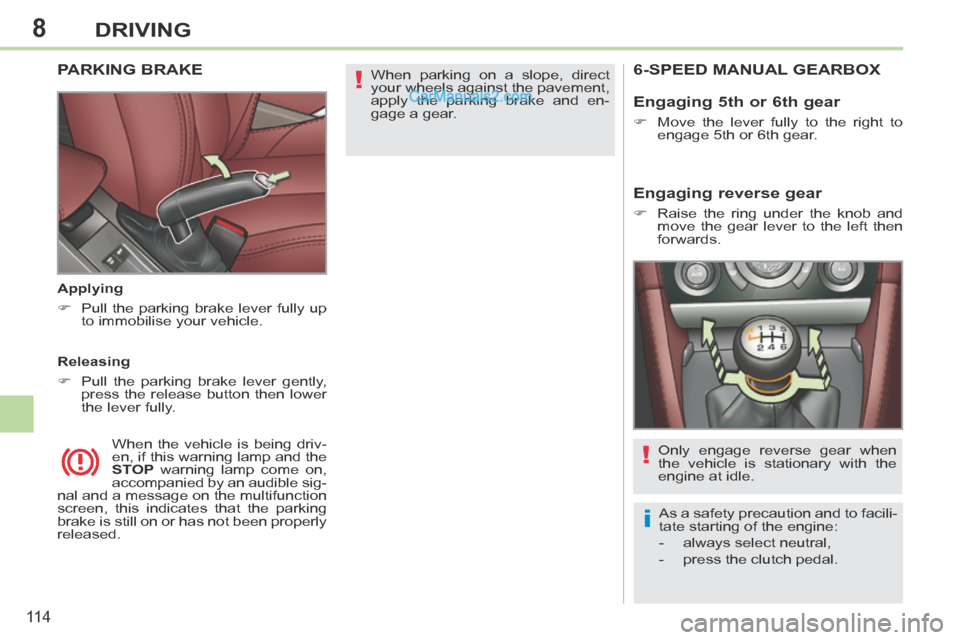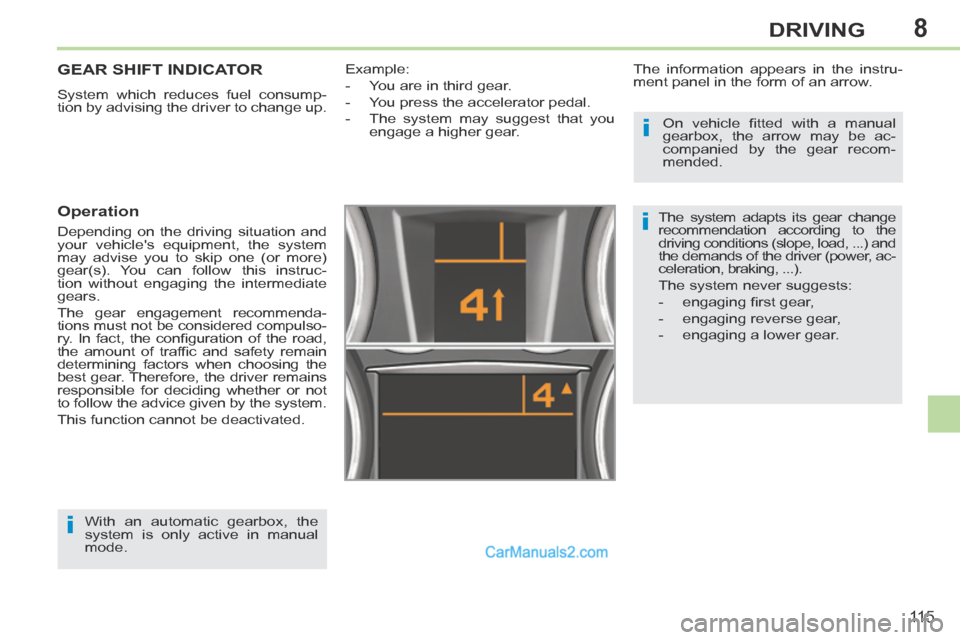2013.5 Peugeot 308 CC gearbox
[x] Cancel search: gearboxPage 5 of 268

3
CONTENTS
Direction indicators 93Hazard warning lamps 93Horn 93Emergency or assistance call 94Braking assistance systems 94Trajectory control systems 95Front seat belts 97Airbags 100Child seats 104Deactivating the passenger's front airbag 105ISOFIX child seats 110
SAFETY 93 11 3
Parking brake 114Manual gearbox 114Gear shift indicator 115Automatic gearbox 116Stop & Start 119Tyre under-infl ation detection 122Speed limiter 124Cruise control 126Parking sensors 128
DRIVING 114 129
Bonnet 131Running out of fuel (Diesel) 132Petrol engines 133Diesel engines 134Checking levels 135Checks 138
CHECKS 130 139
Temporary puncture repair kit 140Changing a wheel 145Snow chains 149Changing a bulb 150Changing a fuse 15512 V battery 161Energy economy mode 164Changing a wiper blade 165Towing the vehicle 165Towing a trailer 167Very cold climate screen 168Accessories 168
PRACTICAL INFORMATION 140 169
Petrol engines 170Weights (petrol) 171Diesel engines 172Weights (Diesel) 173Dimensions 174Identifi cation markings 175
TECHNICAL D ATA 170 D ATA 170 D ATA 176
AUDIO EQUIPMENT and TELEMATICS 177 251
VISUAL SEARCH 252 255
ALPHABETICAL INDEX 256 260
Emergency or assistance 177PEUGEOT Connect Navigation (RT6) 179PEUGEOT Connect Sound (RD5) 233
7
8
9
10
11
Page 19 of 268

!
i
i
11 9 120
17
FAMILIARISATION
DRIVING SAFELY
Stop & Start
The "ECO" warning lamp comes on
in the instrument panel and the en-
gine automatically goes into standby: The "ECO" warning lamp goes
off and the engine restarts auto-
matically:
You can deactivate the system at any
time by pressing the "ECO OFF" but-
ton; the warning lamp in the button
comes on. Deactivation / Reactivation
Going into engine STOP mode Going into engine START mode
- with a manual gearbox: at speeds below 12 mph (20 km/h), when you
place the gear lever into neutral,
and you release the clutch pedal.
In some circumstances, STOP mode may
not be available; the "ECO" warning lamp
fl ashes for few seconds, then goes off.
- with a manual gearbox: when you fully depress the clutch pedal.
If you engage a gear without fully
depressing the clutch pedal, the
engine will not restart automatical-
ly. An alert message is displayed
asking you to fully depress the
clutch pedal. The system is reactivated auto-
matically at every new start using
the key.
Before refuelling or doing anything
under the bonnet, you must switch
off the ignition using the key.
In some circumstances START mode
may be invoked automatically; the
"ECO" warning lamp fl ashes for a few
seconds, then goes off.
Page 20 of 268

126
124
18
FAMILIARISATION
DRIVING SAFELY
Speed limiter "LIMIT"
1. Limiter mode Selection / Off.
2. Decrease the programmed value.
3. Increase the programmed value.
4. Speed limiter On / Off. 1. Cruise control mode Selection / Off.
2. Programme a speed / Decrease the
programmed value.
3. Programme a speed / Increase the programmed value.
4. Cruise control Off / Resume.
Cruise control "CRUISE"
In order to be programmed or activated,
the vehicle speed must be higher than
25 mph (40 km/h), with at least fourth
gear engaged on a manual gearbox
(second gear for an automatic gearbox).
The values must be set with the engine
running.
Display in the instrument panel
The cruise control or speed limiter
mode appears in the instrument panel
when it is selected.
Cruise control
Speed limiter
Page 21 of 268

19
ECO-DRIVING
Eco-driving is a range of everyday practices that allow the motorist to \
optimise their fuel consumption and CO2 emissions.
Optimise the use of your gearbox
With a manual gearbox, move off gently and change up
without waiting. During acceleration change up early.
With an automatic or electronic gearbox, give preference to
automatic mode and avoid pressing the accelerator pedal
heavily or suddenly.
The gear shift indicator invites you engage the most suitable
gear: as soon as the indication is displayed in the instru-
ment panel, follow it straight away.
For vehicles fi tted with an electronic or automatic gearbox,
this indicator appears only in manual mode.
Drive smoothly
Maintain a safe distance between vehicles, use engine
braking rather than the brake pedal, and press the accel-
erator progressively. These practices contribute towards a
reduction in fuel consumption and CO
2 emissions and also
helps reduce the background traffi c noise.
If your vehicle has cruise control, make use of the system at
speeds above 25 mph (40 km/h) when the traffi c is fl owing
well.
Control the use of your electrical equipment
Before moving off, if the passenger compartment is too
warm, ventilate it by opening the windows and air vents
b efore using the air conditioning.
Above 30 mph (50 km/h), close the windows and leave the
air vents open.
Remember to make use of equipment that can help keep the
temperature in the passenger compartment down (s unroof
and window blinds...).
Switch off the air conditioning, unless it has automatic regu-
lation, as soon as the desired temperature is attained.
Switch off the demisting and defrosting controls, if not
a utomatic.
Switch off the heated seat as soon as possible.
Switch off the headlamps and front foglamps when the level
of light does not require their use.
Avoid running the engine before moving off, particularly in
winter; your vehicle will warm up much faster while driving.
As a passenger, if you avoid connecting your multimedia
devices (fi lm, music, video game...), you will contribute
t owards limiting the consumption of electrical energy, and
so of fuel.
Disconnect your portable devices before leaving the vehicle.
Page 23 of 268

1
i
21
MONITORING
INSTRUMENT PANELS, PETROL OR DIESEL, MANUAL OR AUTOMATIC GEARBOX
5. Small screen.
6. Central screen.
7. Control button.
Starts a manual CHECK and recalls the service information.
Resets the function to zero (trip dis- tance recorder or service indicator).
8. Instrument panel lighting dimmer.
Adjusts the brightness of the lighting of the instruments and controls. Dials
1. Rev counter.
Indicates the speed of rotation of the engine (x 1000 rpm).
2. Coolant temperature.
Indicates the temperature of the en- gine coolant (°Celsius).
3. Fuel level.
Indicates the quantity of fuel remain- ing in the tank.
4. Vehicle speed.
Indicates the current speed of the moving vehicle (mph or km/h). A. Trip distance recorder.
(miles or km)
B. Distance recorder.
(miles or km)
C. Engine oil level indicator * ,
service indicator.
(miles or km)
These two functions are displayed when the ignition is switched on,
then disappear after a few seconds.
Displays
For more information, refer to the
section related to the button or
function and its associated display. The following functions are displayed in
accordance with the selection.
- Result of the CHECK.
- Alert messages symbol.
- Speed limiter / Cruise control.
- Gear shift indicator.
- Automatic gearbox.
- Trip computer.
* Depending on version.
Page 24 of 268

1
i
22
MONITORING
INSTRUMENT PANELS, PETROL OR DIESEL, MANUAL OR AUTOMATIC GEARBOX, WITH NAVIGATION
* Depending on version.
Dials
1. Rev counter.
Indicates the speed of rotation of the engine (x 1000 rpm).
2. Coolant temperature.
Indicates the temperature of the en- gine coolant (°Celsius).
3. Fuel level.
Indicates the quantity of fuel remain- ing in the tank.
4. Vehicle speed.
Indicates the current speed of the moving vehicle (mph or km/h). 5. Small screen.
6. Central screen.
7. Control button.
Starts a manual CHECK and recalls
the service information.
Resets the function to zero (trip dis- tance recorder or service indicator).
8. Instrument panel lighting dimmer.
Adjusts the brightness of the lighting of the instruments and controls.
For more information, refer to the
section related to the button or
function and its associated display. Displays
A. Trip distance recorder.
(miles or km)
B. Distance recorder.
(miles or km)
C. Engine oil level indicator * ,
service indicator.
(miles or km)
These two functions are displayed when the ignition is switched on,
then disappear after a few seconds.
The following functions are displayed in
accordance with the selection.
- Result of the CHECK.
- Alert messages.
- Speed limiter / Cruise control.
- Gear shift indicator.
- Automatic gearbox.
-
Navigation - Guidance / Trip computer.
- Repeat of the current speed.
Page 116 of 268

8
!
i
!
11 4
DRIVING
When parking on a slope, direct
your wheels against the pavement,
apply the parking brake and en-
gage a gear. PARKING BRAKE
Applying
Pull the parking brake lever fully up to immobilise your vehicle.
When the vehicle is being driv-
en, if this warning lamp and the
STOP warning lamp come on,
accompanied by an audible sig-
nal and a message on the multifunction
screen, this indicates that the parking
brake is still on or has not been properly
released. Releasing
Pull the parking brake lever gently, press the release button then lower
the lever fully.
6-SPEED MANUAL GEARBOX
As a safety precaution and to facili-
tate starting of the engine:
- always select neutral,
- press the clutch pedal.
Only engage reverse gear when
the vehicle is stationary with the
engine at idle.
Engaging reverse gear
Raise the ring under the knob and
move the gear lever to the left then
forwards.
Engaging 5 th or 6 th gear
Move the lever fully to the right to engage 5 th or 6 th gear.
Page 117 of 268

8
i
i
i
11 5
DRIVING
GEAR SHIFT INDICATOR
System which reduces fuel consump-
tion by advising the driver to change up.
Operation
Depending on the driving situation and
your vehicle's equipment, the system
may advise you to skip one (or more)
gear(s). You can follow this instruc-
tion without engaging the intermediate
gears.
The gear engagement recommenda-
tions must not be considered compulso-
ry. In fact, the confi guration of the road,
the amount of traffi c and safety remain
determining factors when choosing the
best gear. Therefore, the driver remains
responsible for deciding whether or not
to follow the advice given by the system.
This function cannot be deactivated. The information appears in the instru-
ment panel in the form of an arrow.
The system adapts its gear change
recommendation according to the
driving conditions (slope, load, ...) and
the demands of the driver (power, ac-
celeration, braking, ...).
The system never suggests:
- engaging fi rst gear,
- engaging reverse gear,
- engaging a lower gear.
Example:
- You are in third gear.
- You press the accelerator pedal.
- The system may suggest that you
engage a higher gear.
With an automatic gearbox, the
system is only active in manual
mode. On vehicle fi tted with a manual
gearbox, the arrow may be ac-
companied by the gear recom-
mended.